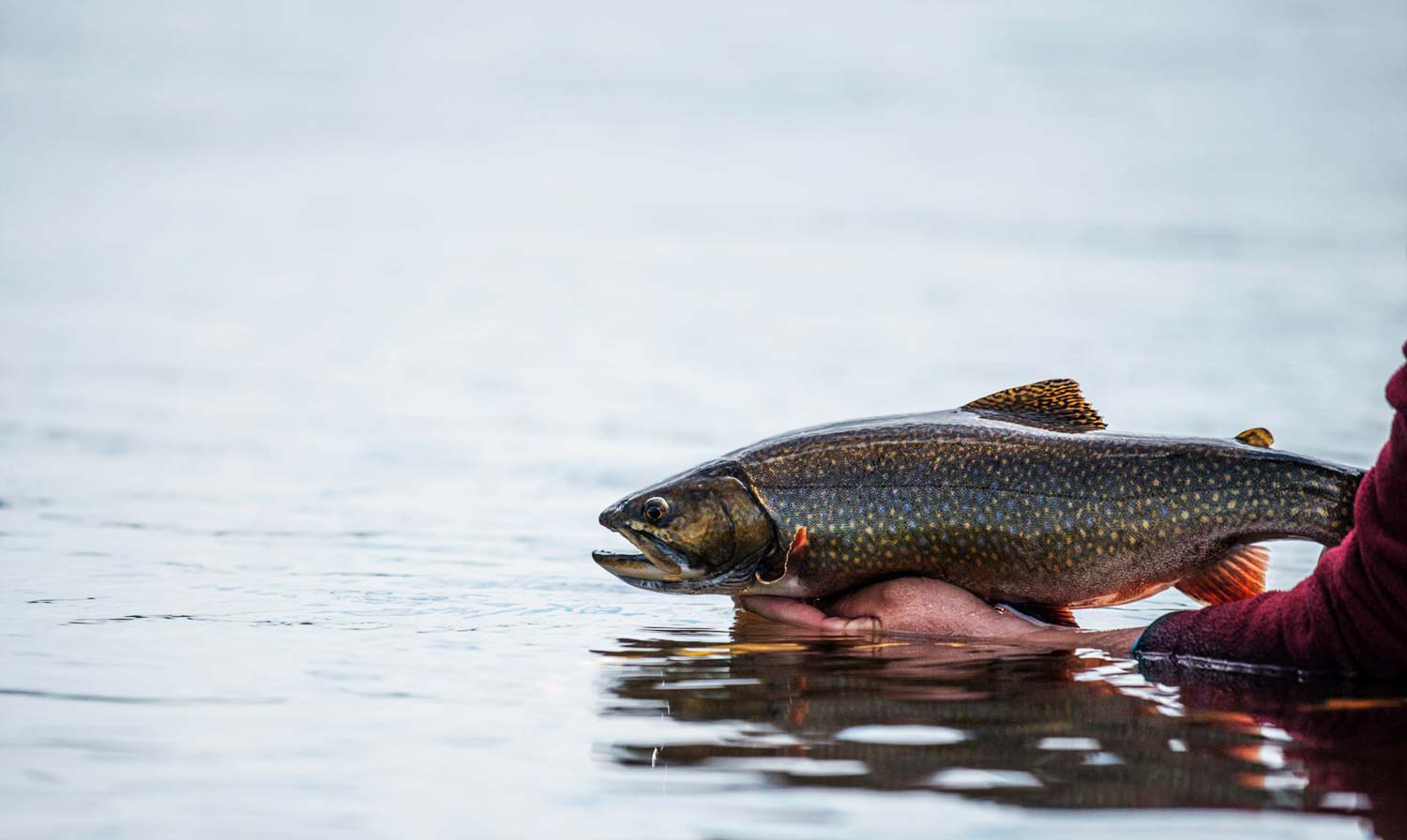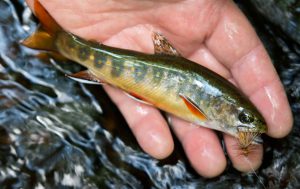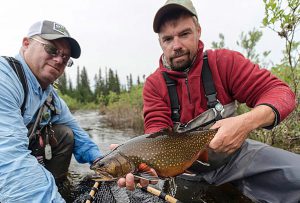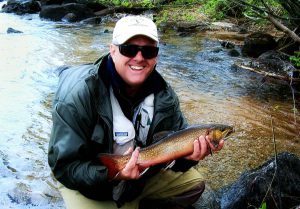
Photo by Dave Karczynski
By Jason Tucker
I recently read an article on brook trout, about what beautiful delicate gems they are.
It’s true for a lot of us that brook trout are a small, colorful, feisty reward for a day’s fishing. They are often some of the smallest fish we seek. They normally live in the smallest streams and creeks, or in the headwaters of our trout streams where it is easier to step across than wade them. Yeah, we’ve heard of bigger fish in far off destinations, but surely these are the exception, fish that through a series of happy accidents go against the grain and get unusually large.
That would be a complete misconception, and the small fish that most of us see and catch, at least in the United States, are fish holding on at the margins of their range, in remnants of water barely suitable for their existence.
It is impossible to understand brook trout without fishing for them in their Canadian strongholds.
The small, delicate looking gems we are used to seeing in the United States are only representative of one form of the species. It is a truly remarkable adaptation that extends their range far outside of what it could normally be, but it doesn’t fully represent the species.

Photo Louis Cahill
Living in a small, headwaters-dwelling form has distinct ecological and evolutionary advantages, allowing them to hang on in areas that have generally become unsuitable for them. In effect, brook trout are superbly adapted to Ice Age cycles, in which their northern habitat becomes unlivable every ten thousand years or so due to encroaching glaciation. Brook trout colonize the leading edges of the glaciers, which have taken them south, all the way into the Smokey Mountains of northern Georgia, a place that is otherwise inhospitable for brook trout. When the glaciers retreat, remnant populations are left in the few waters that remain cold and clean enough to harbor them, usually high up on the mountains. These small stream trout are usually quite small themselves, rarely reaching a pound in weight, and often living only about three years.
Their prime range however, covers a vast area of Canadian Shield country that runs from western Ontario, Lake Superior in the south, on up to Hudson Bay in the north, across all of Quebec, and on east to Labrador.
In this region the lakes and streams they live in are ice covered half of the year, but still livable. In summer the water never warms above ideal temperatures for the trout. Food is abundant, and so are predators including large lake trout and northern pike. In this vast region brook trout average far bigger than what we are used to seeing in the United States. They regularly reach 3-10 pounds and over 20 inches in length. The average fish will be right around 20 inches long.

Photo Dave Karczynski
Interestingly, a five pound brook trout is not necessarily a lot older than an 8 incher in a small stream.
They could be the same age, and it still is not understood exactly what triggers the growth of the larger fish. There are factors such as water body size and food base, pH of the water, and year-round temperature stability. One factor that gets talked about is the presence of predators. In a healthy ecosystem full of predators, brook trout that quickly bulk up to be too big to fit down the gullet of a pike or lake trout live longer and spawn more. Some researchers believe that it is the presence of big pike that triggers them to grow fast. I can attest that in Labrador the water is full of giant pike, big lakers, and big brook trout.
One thing to consider about the toughness and resilience of brook trout- they are part of a suite of species that generally occur together. These include lake trout, northern pike and whitefish. All four are affected by glaciation during ice ages. Of the four, only brook trout are capable of hanging on far to the south of their normal range during inter-glacial periods.
One of the great revelations of a recent trip to Labrador was seeing brook trout exist in both of their forms side by side.

Photo Dan Flynn
I have seen this in the Nipigon region of Ontario as well. The small streams were populated with small-stream fish, and the big water held the large form. The differences were obvious to the naked eye, and I had a distinct feeling that the small stream fish did not grow larger and leave the small streams but remained in that form in that environment. What this would mean is that brook trout are capable of living in all the habitat available to them in the form that is most suited to that habitat. If something were to happen in the bigger water (such as further retreat of cold water; global warming making it inhospitable to brook trout) they would still survive in the colder, smaller streams. And when the next glaciation makes its way south, not only will it push brook trout back ahead of it, but they will be met by their brethren left behind 10,000 or 20,000 years ago.
So the next time you are holding one of these small gems, take a moment to reflect on their toughness and resilience. Consider, too, that you are also holding onto a small representative, adapted to holding on at the margins of its range, awaiting the return of the ice, and the opportunity to grow large again.
Jason writes the fine blog Fontinalis Rising
Jason Tucker
Gink & Gasoline www.ginkandgasoline.com hookups@ginkandgasoline.com Sign Up For Our Weekly Newsletter!
I read your article and liked it but I’m from NH and have fished all over
N.E. let’s not forget about the brookies in these areas as well… I’ve caught some sizable Brook trout all across N.E. In places you wouldn’t think possible to hold them….
Totally agree I’m from Maine and fish almost 100% for brook trout only rarely breaking off for togue splake or land lockeds… I have caught 5 fish over 4 pounds one of them being 6 pounds.. maybe they aren’t as plentiful but they are here
Good story, I lived in NH for a majority of my life. And fished all over NE. let’s not forget the Brookie fishing in this region… I’ve caught many of fat Brook trout in places you wouldn’t have thought that fat brookies would be….
Pingback: Getting the Big Picture On Brook Trout | Fly Fishing | Gink and Gasoline | How to Fly Fish | Trout Fishing | Fly Tying | Fly Fishing Blog
Good job!! Nice informative article that explains the diversity in size of the Brook trout well. Keep up the good work.!!
For brook trout’s sake, and our own, let’s hope we address climate change in time that there can be another glaciation period.
Shared! This is AWESOME stuff! Thank you!